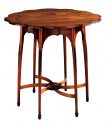Un aperçu sur la carrière du finisseur de meubles

Chaque pièce de votre logement ou de votre école possède des meubles. Les personnes de métiers qui s’assurent que ces meubles sont beaux sont les finisseurs de meubles. Comme leur nom l’indique, ces personnes travaillent à la fin de la fabrication des meubles. Si vous avez des capacités en création, des compétences de travail manuel et un intérêt pour les meubles agréables et sans danger, le métier de finisseur de meubles pourrait vous plaire.
En général, les finisseurs de meubles travaillent dans les usines, les magasins de meubles et les ateliers de réparation. Certains sont indépendants, mais d’autres travaillent dans de grandes entreprises. Dans les usines, ils travaillent, en principe, sur des meubles neufs, en appliquant de la teinture et du vernis sur le bois et de la peinture sur le métal. Ailleurs, ils peuvent travailler sur tout meuble neuf ou d’occasion, du petit tabouret à la grande table de salle à manger et à l’armature d’un sofa. Parfois, les vieux meubles peuvent être fragiles, les finisseurs de meubles doivent donc être particulièrement prudents pour éviter de les endommager.
Sauf dans les usines, les finisseurs de meubles travaillent principalement sur de vieux meubles que des gens veulent restaurer ou améliorer. Parfois, les finisseurs de meubles ont besoin de réparer ou sabler des parties rugueuses de chaises ou de tables pour éviter que les gens se blessent avec des échardes ou se coupent sur des bords râpeux. Dans les grandes usines, ils peuvent travailler seulement sur une petite partie de la fabrication, mais dans les plus petites entreprises, ils peuvent accomplir d’autres tâches, comme assembler les meubles ou travailler sur la vente. Pour beaucoup de personnes de ce domaine, c’est important de pouvoir travailler avec les autres et de bien interagir avec le public.
Habituellement, les finisseurs de meubles ont besoin du diplôme d’études secondaires ou d’une équivalence, pour travailler dans l’entreprise. Des cours en mathématiques et en anglais sont utiles. Ça peut être aussi judicieux de suivre un apprentissage dans une école des métiers, mais la plupart des gens apprennent le métier sur le tas. Avoir un bon sens des couleurs est utile pour faire correspondre la teinture du meuble avec le rembourrage ou la teinte du métal avec les autres meubles d’une pièce. Des compétences en mathématiques sont utiles pour calculer les quantités de matériaux nécessaires ou pour des tâches de comptabilité ainsi qu’une capacité de lecture assez élevée pour comprendre des instructions écrites sur les pots de peinture ou d’autres produits.
Le travail de finisseur de meubles n’est pas dangereux, même si de petites blessures comme les coupures et les poignets foulés font partie des principaux aléas du métier. Les émanations des peintures et des teintures peuvent aussi être dangereuses et les finisseurs de meubles ont peut-être besoin de porter des masques particuliers pour éviter d’endommager leurs poumons. Les journées peuvent être longues si un travail est entamé, surtout parce que les teintures et les peintures sont plus belles lorsqu’elles sont appliquées uniformément. Pour les finisseurs de meubles, le salaire commence à environ 15 $ l’heure et peut monter jusqu’à 27 $ l’heure avec de l’expérience, ou entre 31 000 $ et 56 000 $ par année.
La finition de meubles est le genre de travail que les personnes peuvent faire pendant beaucoup d’années si elles le souhaitent. Une assez bonne vision et un niveau de force minimale sont importants et les personnes de ce métier devraient pouvoir se baisser et se pencher sans trop de problèmes. Cependant, ce métier peut devenir trop difficile pour les travailleurs plus âgés qui peuvent vouloir changer pour un travail de bureau dans le domaine. Si ce métier vous plait, travailler comme finisseur de meubles pourrait être un bon choix de carrière.
Bibliographie :
Career One Stop. “Furniture Finishers.” https://www.careeronestop.org/toolkit/careers/occupations/occupation-profile.aspx?keyword=Furniture%20Finishers&onetcode=51702100&location=Maine.
Job Bank. “Furniture Finishing in Canada.” https://www.jobbank.gc.ca/marketreport/summary-occupation/12759/ca.
Payscale Canada. “Furniture Finisher: Hourly Rate.” https://www.payscale.com/research/CA/Job=Furniture_Finisher/Hourly_Rate.
Work BC. “Furniture Finishers and Refinishers (NOC 9534).” https://www.workbc.ca/careers/9534.





Laisser un commentaire!